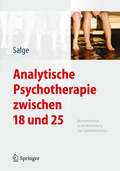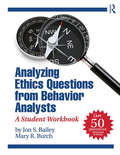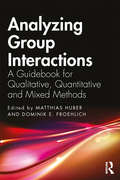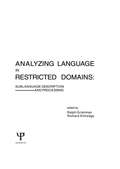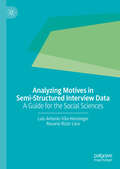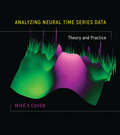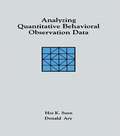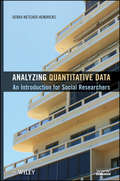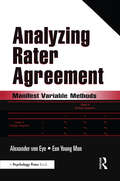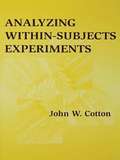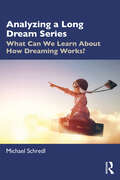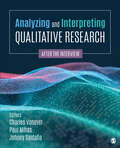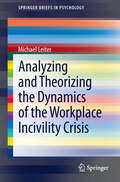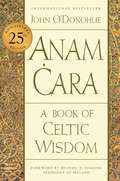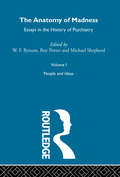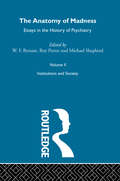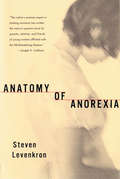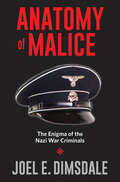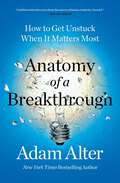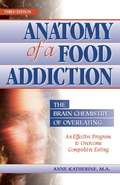- Table View
- List View
Analytische Psychotherapie zwischen 18 und 25: Besonderheiten in der Behandlung von Spätadoleszenten (Psychotherapie: Praxis)
by Holger SalgePsychotherapie mit Patienten im Übergang zum Erwachsenwerden Die Spätadoleszenz ist eine Zeit des Abschieds. Eines Abschieds von den Eltern, von einem gesellschaftlichen Schutzraum (der bis dato Handeln ohne allzu weitreichende Konsequenzen ermöglichte) und von kompensierenden Omnipotenz- und Grandiositätsvorstellungen. Durch den Verlust äußerlich strukturierender Gegebenheiten kommt in dieser Lebensphase die "innere Ausstattung" auf den Prüfstand. In der Versorgungspraxis besteht eine Besonderheit bei der Psychotherapie junger Erwachsener: Je nach Alter beim Behandlungsbeginn werden die jungen Patientinnen und Patienten von Kinder- und Jugendlichenpsychotherapeuten oder von Erwachsenentherapeuten behandelt. Die Praxis zeigt oft: Beide Therapeutengruppen sind unzureichend auf diese Patientengruppe vorbereitet. Praxisorientiert: Nutzen und Fallstricke in der Therapie Der therapeutische Umgang mit Patientinnen und Patienten in dieser Lebensphase (18-25 Jahre) stellt besondere Anforderungen an die Therapeutin, den Therapeuten und spielt sich ab im Spannungsfeld von - diagnostischer Unsicherheit und heftigen Gegenübertragungsreaktionen auf Seiten der Therapeutinnen und Therapeuten bzw. des therapeutischen Teams sowie - Sprachlosigkeit, Ambivalenz gegenüber dem therapeutischen Angebot, massiver Scham und (unbewusster) Angst vor der eigenen Destruktivität auf Seiten des jungen Patienten. Dieses Buch bietet eine praxisorientierte Einführung in die Besonderheiten der Psychotherapie mit Spätadoleszenten und jungen Erwachsenen. Geschrieben für analytische und tiefenpsychologische Psychotherapeuten in Ausbildung und Praxis, aber auch Praktiker anderer theoretischer Orientierung, die sich mit der Therapie und Beratung von Patienten zwischen 18 und 25 vertraut machen möchten
Analyzing Ethics Questions from Behavior Analysts: A Student Workbook
by Jon S. Bailey Mary R. BurchSupplementing the best-selling textbook, Ethics for Behavior Analysts, this book analyzes over 50 original and up-to-date ethics cases recently faced by behavior analysts. The workbook provides "solutions" to each question written by the most expert professionals in the field using the Behavior Analyst Certification Board® Ethics Code. Covering all ten sections of the code and designed to allow the reader to see the original question, respond given their knowledge of the Code, and then compare their answers with the authors’ answers at the back of the book, Jon S. Bailey and Mary R. Burch provide the necessary guided practice for both students and clinicians to improve ethical competency in behavior analysis.
Analyzing Group Interactions: A Guidebook for Qualitative, Quantitative and Mixed Methods
by Matthias Huber Dominik E. FroehlichAnalyzing Group Interactions gives a comprehensive overview of the use of different methods for the analysis of group interactions. International experts from a range of different disciplines within the social sciences illustrate their step-by-step procedures of how they analyze interactions within groups and explain what kind of data and skills are needed to get started. Each method is discussed in the same, structured manner, focusing on each method’s strengths and weaknesses, its applicability and requirements, and the precise workflow to "follow along" when analyzing group interactions with the respective method. The analyzing strategies covered in this book include ethnographical approaches, phenomenology, content analysis, documentary method, discourse analysis, grounded theory, social network analysis, quantitative ratings, and several triangulative and mixed-method research designs. This volume is recommended for researchers at all levels that need guidance with the complex task of analyzing group interactions. The unified structure throughout the book facilitates comparison across the different methods and helps with deciding on the approach to be taken.
Analyzing Language in Restricted Domains: Sublanguage Description and Processing
by Ralph Grishman and Richard KittredgeFirst published in 1986. Routledge is an imprint of Taylor & Francis, an informa company.
Analyzing Memory: The Formation, Retention, and Measurement of Memory (The\mit Press Ser.)
by Richard A. ChechileAn accessible synthesis of memory research that discusses the creation of memory representations, the processes of storage and retrieval, and the effectiveness of encoding information.The field of memory research is subdivided into many separate and non-overlapping topic areas that often employ specialized tools and models. This book offers an accessible synthesis of memory research that explores how memory works, how it is organized, and how it changes dynamically. Written by an expert in the field, it can be used by undergraduate and graduate students of psychology and as a reference by researchers who want to fill in gaps in their knowledge. The book focuses on three general topics that cover a vast amount of research in the field: how a memory representation is created, how the cognitive processes of storage and retrieval can be studied and measured, and the process of encoding information and its varying degrees of effectiveness. Specific subjects addressed include habituation and sensitization, and the neurobiological changes that underlie them; evidence for a cognitive component underlying Pavlovian conditioning; biological constraints on a cognitive model of memory; an information-processing framework for memory; misconceptions about memory, including the static memory myth and the permanent memory myth; model-based measurement of storage and retrieval processes; a critique of the concept of memory strength; the distinction between implicit and explicit memory; and learning and repetition. Although the writing is accessible to the nonspecialist, the density of information is high. The text avoids jargon, and a glossary defines key terms. The notes expand on technical details and point to interesting related ideas.
Analyzing Motives in Semi-Structured Interview Data: A Guide for the Social Sciences
by Luis Antonio Vila-Henninger Rosario Rizzo LaraThis book advances the emerging work on using semi-structured interview data to analyze motives by providing the first book-length treatment of this underdeveloped methodological area in sociology and social science more broadly. Exploring key methodological and theoretical debates on this topic in-depth, the authors apply a dual-process model approach to demonstrate how we can analyze motives effectively in semi-structured interview data, and in tandem, understand the sociological reasoning behind society's moral judgments and political decision-making. Additionally, the authors develop the accessible and rigorous 5Rs methodology, which synthesizes insights from an array of literatures into a novel, cohesive analytic tool for analyzing motives in semi-structured interview data. Balancing transparency with theoretical nuance, it enables researchers to revisit and reuse previously collected data that may have been considered unsuitable for motive analysis, either because of prevailing disciplinary assumptions, or because of how data were initially framed and coded. Applicable to various cultural contexts and disciplines, the methodology explored in this book is thus of international interest to researchers and students of qualitative sociology, sociology of culture and cognition, migration studies, cognitive science, and moral psychology, with wider implications for qualitative methodologies in the social sciences.
Analyzing Neural Time Series Data: Theory and Practice (Issues In Clinical And Cognitive Neuropsychology Ser.)
by Mike X CohenA comprehensive guide to the conceptual, mathematical, and implementational aspects of analyzing electrical brain signals, including data from MEG, EEG, and LFP recordings.This book offers a comprehensive guide to the theory and practice of analyzing electrical brain signals. It explains the conceptual, mathematical, and implementational (via Matlab programming) aspects of time-, time-frequency- and synchronization-based analyses of magnetoencephalography (MEG), electroencephalography (EEG), and local field potential (LFP) recordings from humans and nonhuman animals. It is the only book on the topic that covers both the theoretical background and the implementation in language that can be understood by readers without extensive formal training in mathematics, including cognitive scientists, neuroscientists, and psychologists.Readers who go through the book chapter by chapter and implement the examples in Matlab will develop an understanding of why and how analyses are performed, how to interpret results, what the methodological issues are, and how to perform single-subject-level and group-level analyses. Researchers who are familiar with using automated programs to perform advanced analyses will learn what happens when they click the “analyze now” button.The book provides sample data and downloadable Matlab code. Each of the 38 chapters covers one analysis topic, and these topics progress from simple to advanced. Most chapters conclude with exercises that further develop the material covered in the chapter. Many of the methods presented (including convolution, the Fourier transform, and Euler's formula) are fundamental and form the groundwork for other advanced data analysis methods. Readers who master the methods in the book will be well prepared to learn other approaches.
Analyzing Quantitative Behavioral Observation Data
by Donald Ary Hoi K. SuenThis volume provides a comprehensive summary of developments in theories and techniques within the areas of sampling, measurement, and statistical methods for analyzing behavioral data. By unifying new theories, techniques, methodologies, terminology, and language in behavioral observation research, the authors provide a comprehensive source for students and researchers.
Analyzing Quantitative Data
by Debra Wetcher-HendricksA user-friendly, hands-on guide to recognizing and conducting proper research techniques in data collection Offering a unique approach to numerical research methods, Analyzing Quantitative Data: An Introduction for Social Researchers presents readers with the necessary statistical applications for carrying out the key phases of conducting and evaluating a research project. The book guides readers through the steps of data analysis, from organizing raw data to utilizing descriptive statistics and tests of significance, drawing valid conclusions, and writing research reports. The author successfully provides a presentation that is accessible and hands-on rather than heavily theoretical, outlining the key quantitative processes and the use of software to successfully draw valid conclusions from gathered data. In its discussion of methods for organizing data, the book includes suggestions for coding and entry into spreadsheets or databases while also introducing commonly used descriptive statistics and clarifying their roles in data analysis. Next, inferential statistics is explored in-depth with explanations of and instructions for performing chi-square tests, t-tests, analyses of variance, correlation and regression analyses, and a number of advanced statistical procedures. Each chapter contains explanations of when to use the tests described, relevant formulas, and sample computations. The book concludes with guidance on extracting meaningful conclusions from statistical tests and writing research reports that describe procedures and analyses. Throughout the book, Statistical Resources for SPSS® sections provide fundamental instruction for using SPSS® to obtain the results presented. Where necessary, the author provides basic theoretical explanations for distributions and background information regarding formulas. Each chapter concludes with practice problems, and a related website features derivations of the book's formulas along with additional resources for performing the discussed processes. Analyzing Quantitative Data is an excellent book for social sciences courses on data analysis and research methods at the upper-undergraduate and graduate levels. It also serves as a valuable reference for applied statisticians and practitioners working in the fields of education, medicine, business and public service who analyze, interpret, and evaluate data in their daily work.
Analyzing Rater Agreement: Manifest Variable Methods
by Alexander von Eye Eun Young MunAgreement among raters is of great importance in many domains. For example, in medicine, diagnoses are often provided by more than one doctor to make sure the proposed treatment is optimal. In criminal trials, sentencing depends, among other things, on the complete agreement among the jurors. In observational studies, researchers increase reliability by examining discrepant ratings. This book is intended to help researchers statistically examine rater agreement by reviewing four different approaches to the technique.The first approach introduces readers to calculating coefficients that allow one to summarize agreements in a single score. The second approach involves estimating log-linear models that allow one to test specific hypotheses about the structure of a cross-classification of two or more raters' judgments. The third approach explores cross-classifications or raters' agreement for indicators of agreement or disagreement, and for indicators of such characteristics as trends. The fourth approach compares the correlation or covariation structures of variables that raters use to describe objects, behaviors, or individuals. These structures can be compared for two or more raters. All of these methods operate at the level of observed variables.This book is intended as a reference for researchers and practitioners who describe and evaluate objects and behavior in a number of fields, including the social and behavioral sciences, statistics, medicine, business, and education. It also serves as a useful text for graduate-level methods or assessment classes found in departments of psychology, education, epidemiology, biostatistics, public health, communication, advertising and marketing, and sociology. Exposure to regression analysis and log-linear modeling is helpful.
Analyzing Violence Against Women (Library of Public Policy and Public Administration #12)
by Wanda TeaysThis timely anthology brings into sharp relief the extent of violence against women. Its range is global and far reaching in terms of the number of victims. There are deeply entrenched values that need to be rooted out and laid bare.This text offers a philosophical analysis of the problem, with important insights from the various contributors. Topics range from sexual assault to media violence, prostitution and pornography, domestic violence, and sexual harassment. Each of the four parts include essays which tackle these issues and provide us with tools for bringing about change.The philosophical approaches to the topic give readers insight into the harms of interpersonal violence and its impact on the lives of its victims. Analyzing Violence Against Women calls us to examine public policies and work for systemic change. In the process, we are reminded that the concerns of the discipline of Philosophy encompasses issues with a wider scope.Students will especially benefit from seeing how the various authors grapple with this pressing issue and clarify why we need to bring about change.
Analyzing Within-subjects Experiments
by John W. CottonMost behavioral scientists know two important concepts -- how to analyze continuous data from randomly assigned treatment groups of subjects and how to assess practice effects for a single group of subjects given a constant treatment at each of several stages of practice. However, except in the case of the repeated measures Latin square design, researchers are not facile in analyzing data from different subjects receiving different treatments at various times in an experiment. This book helps fill the void.
Analyzing a Long Dream Series: What Can We Learn About How Dreaming Works?
by Michael SchredlAnalyzing a Long Dream Series provides an extraordinary insight into the richness and variability of dreams, considering over 12,000 dreams that have been recorded for more than 30 years.Internationally recognized dream scientist Michael Schredl opens up his own personal dream series, offering a unique window into the interplay between waking life and dreaming. The book considers a huge range of dream topics, including family, friends, schoolmates, colleagues, erotic dreams, alongside the appearance of everyday objects. It also discusses rarer themes such as pain perception, temperature perception, and typical dreams about toilets, exams, and teeth. As the author is both the dreamer and the researcher, questions like why we dream about topics we have never experienced in waking life – for example, about the pain of being shot in the stomach – can be addressed, shedding light on the creative nature of dreams. The in-depth analyses provided in this book attempt to answer the field's most profound questions: why do we dream every night, and why do we dream in such creative ways about the issues that are important to us in waking life? The dreams analyzed question existing dream theories such as simulation theories, and the author proposes a function of recalled dreams for creative problem solving and provides ideas for future research.This fascinating book is an essential read for all dream researchers and students of the psychology of dreams.
Analyzing and Interpreting Qualitative Research: After the Interview
by Johnny Saldaña Charles Vanover Paul MihasThis text provides comprehensive coverage of the key methods for analyzing, interpreting, and writing up qualitative research in a single volume, and drawing on the expertise of major names in the field. Covering all the steps in the process of analyzing, interpreting, and presenting findings in qualitative research, the authors utilize a consistent chapter structure that provides novice and seasoned researchers with pragmatic, "how-to" strategies. Each chapter introduces the method; uses one of the authors′ own research projects as a case study of the method described; shows how the specific analytic method can be used in other types of studies; and concludes with questions and activities to prompt class discussion or personal study.
Analyzing and Interpreting Qualitative Research: After the Interview
by Johnny Saldaña Charles Vanover Paul MihasThis text provides comprehensive coverage of the key methods for analyzing, interpreting, and writing up qualitative research in a single volume, and drawing on the expertise of major names in the field. Covering all the steps in the process of analyzing, interpreting, and presenting findings in qualitative research, the authors utilize a consistent chapter structure that provides novice and seasoned researchers with pragmatic, "how-to" strategies. Each chapter introduces the method; uses one of the authors′ own research projects as a case study of the method described; shows how the specific analytic method can be used in other types of studies; and concludes with questions and activities to prompt class discussion or personal study.
Analyzing and Theorizing the Dynamics of the Workplace Incivility Crisis (SpringerBriefs in Psychology #8)
by Michael LeiterContemporary worklife builds upon a foundation for teamwork among skilled and dedicated people. Despite the utility of supportive working relationships and despite extensive consulting activity on leadership and team building, employees complain extensively about mistreatment by their bosses and colleagues. Analyzing and Theorizing the Dynamics of the Workplace Incivility Crisis presents a theoretic framework for considering the fundamental issues of group dynamics and individual psychology that lie behind this ongoing workplace incivility crisis. It contextualizes the need for belonging as a motivation that shapes expressed social behaviour and intensifies received social behaviour. Looking at cognitive elements as well as rudeness rationales that pertain to workplace incivility and its justification, this work maps social constructs, including the role of team leadership, that lead to setting implicit social norms. In addition to formulating a theoretical framework, Analyzing and Theorizing the Dynamics of the Workplace Incivility Crisis considers methods to address the dynamics that perpetuate incivility at work and actively points at setting an action agenda to evaluate their impact.
Anam Cara [Twenty-fifth Anniversary Edition]: A Book of Celtic Wisdom
by John O'Donohue“In this twenty-fifth anniversary edition, you will find John a “soul friend” on your own journey through life, offering support and solace, clarity, and consciousness—expanding narratives that invite you to experience relationships with people, nature, and even your inner world in new ways that nurture well-being and resilience in these challenging times.” —Daniel J. Siegel, MD, Neuropsychiatrist and New York Times Bestselling AuthorA special twenty-fifth anniversary edition of the classic work of Celtic spirituality and mysticism by beloved poet and philosopher, John O'Donohue, with a new introduction by the President of Ireland, Michael D. Higgins, an afterword by the late author’s brother, Pat O'Donohue, and insightful material from O'Donohue's circle of close friends.In this revered classic, John O’Donohue excavates themes of friendship, belonging, solitude, creativity and the imagination, among many others. Widely recognized for bringing Celtic spirituality into modern dialogue, his unique insights from the ancient world speak with urgency for our need to rediscover the thresholds of the soul. With lyrical wisdom and fluency, O'Donohue encourages pathways of discovery to come home to the natural rhythm in ourselves in sacred connection with one another and the landscapes we inhabit. This timeless collection nourishes the heart and elevates the spirit. It is "a book to read and reread forever.” (Irish Times)
Anatomy Of Madness Vol 1: People And Ideas (Routledge Library Editions Ser.)
by Roy Porter Michael Shepherd W F BynumFirst Published in 2004. Routledge is an imprint of Taylor & Francis, an informa company.
Anatomy Of Madness Vol 2: People And Ideas (Routledge Library Editions Ser.)
by Roy Porter Michael Shepherd W F BynumFirst Published in 2004. Routledge is an imprint of Taylor & Francis, an informa company.
Anatomy Of Madness Vol 3: People And Ideas (Routledge Library Editions Ser.)
by Roy Porter Michael Shepherd W F BynumFirst Published in 2004. Routledge is an imprint of Taylor & Francis, an informa company.
Anatomy of Anorexia
by Steven Levenkron"Invaluable to clinicians, parents, teenagers, and adults who are struggling with anorexia." —Lynn E. Ponton, M.D. Anatomy of Anorexia is a tremendous tool for families: now more than ever, early diagnosis and treatment, and family participation, are crucial in helping the anorexic. Preeminent therapist Steven Levenkron demystifies this life-threatening disease and shows how the millions of girls and women who are afflicted with anorexia can be helped—and can look forward to rich and productive lives. "The nation’s premier expert in treating anorexia has written the nation’s premier book for parents, relatives, and friends of young women afflicted with this life-threatening disease."—Joseph A. Califano Jr., president of the National Center on Addiction and Substance Abuse at Columbia University and former U.S. Secretary of Health, Education, and Welfare "[Levenkron’s] insights, descriptions of family relationships, and treatment recommendations for therapists create a rich, deep, and most helpful guide for a community of people whose lives are deeply and painfully affected by this persistent illness."—Samuel C. Klagsbrun, M.D.
Anatomy of Malice: The Enigma of the Nazi War Criminals
by Joel E. DimsdaleAn eminent psychiatrist delves into the minds of Nazi leadershipin &“a fresh look at the nature of wickedness, and at our attempts to explain it&” (Sir Simon Wessely, Royal College of Psychiatrists). When the ashes had settled after World War II and the Allies convened an international war crimes trial in Nuremberg, a psychiatrist, Douglas Kelley, and a psychologist, Gustave Gilbert, tried to fathom the psychology of the Nazi leaders, using extensive psychiatric interviews, IQ tests, and Rorschach inkblot tests. The findings were so disconcerting that portions of the data were hidden away for decades and the research became a topic for vituperative disputes. Gilbert thought that the war criminals&’ malice stemmed from depraved psychopathology. Kelley viewed them as morally flawed, ordinary men who were creatures of their environment. Who was right? Drawing on his decades of experience as a psychiatrist and the dramatic advances within psychiatry, psychology, and neuroscience since Nuremberg, Joel E. Dimsdale looks anew at the findings and examines in detail four of the war criminals, Robert Ley, Hermann Göring, Julius Streicher, and Rudolf Hess. Using increasingly precise diagnostic tools, he discovers a remarkably broad spectrum of pathology. Anatomy of Malice takes us on a complex and troubling quest to make sense of the most extreme evil. &“In this fascinating and compelling journey . . . a respected scientist who has long studied the Holocaust asks probing questions about the nature of malice. I could not put this book down.&”—Thomas N. Wise, MD, Johns Hopkins University School of Medicine &“This harrowing tale and detective story asks whether the Nazi War Criminals were fundamentally like other people, or fundamentally different.&”—T.M. Luhrmann, author of How God Becomes Real
Anatomy of a Breakthrough: How to Get Unstuck When It Matters Most
by Adam AlterA &“captivating…constructive&” (Adam Grant, #1 New York Times bestselling author of Think Again) guide to breaking free from the thoughts, habits, jobs, relationships, and even business models that prevent us from achieving our full potential.Almost everyone feels stuck in some way. Whether you&’re muddling through a midlife crisis, wrestling with writer&’s block, trapped in a thankless job, or trying to remedy a fraying friendship, the resulting emotion is usually a mix of anxiety, uncertainty, fear, anger, and numbness. But it doesn&’t have to be this way. Anatomy of a Breakthrough is the &“deeply researched and compelling&” (Cal Newport, New York Times bestselling author of Digital Minimalism) roadmap we all need to escape our inertia and flourish in the face of friction. Adam Alter has spent the past two decades studying how people become stuck and how they free themselves to thrive. Here, he reveals the formula he and other researchers have uncovered. The solution rests on a process that he calls a friction audit—a systematic procedure that uncovers why a person or organization is stuck, and then suggests a path to progress. The friction audit states that people and organizations get unstuck when they overcome three sources of friction: HEART (unhelpful emotions); HEAD (unhelpful patterns of thought); and HABIT (unhelpful behaviors). Despite the ubiquity of friction, there are many great &“unstickers&” hidden in plain sight among us and Alter shines a light on some exceptional stories to share their valuable lessons with us. He tells us about the sub-elite swimmer who unstuck himself twice to win two Olympic gold medals, the actor who faced countless rejections before gaining worldwide fame, the renowned painter who became paralyzed and had to relearn to paint with a brush strapped to his wrist, and Alter&’s own story of getting unstuck from a college degree that made him deeply unhappy. Artfully weaving together scientific studies, anecdotes, and interviews, Alter teaches us that getting stuck is a feature rather than a glitch on the road to thriving, but with the right tweaks and corrections, we can reach even our loftiest targets.
Anatomy of a Food Addiction
by Anne Katherine, M.A.If you have struggled with compulsive eating, dieting, and the guilt and conflict they bring, your life will be changed by this important, life-affirming, and astonishingly wise book. Anne Katherine, a Certified Eating Disorders Therapist and former compulsive eater, explains the chemical reactions in the brain that work in conjunction with lifelong emotional conflicts to make food--particularly sugar and refined carbohydrates--such a comfort that it's almost like a drug. Once you realize that your binge eating is a physical disease that can be treated, you can use the book's self-tests, exercises, examination of family issues, and complete recovery program for newfound understanding and confidence.
Anatomy of a Secret Life
by Gail SaltzWhat do these people have in common? • The traveling businessman who brings prostitutes back to his hotel room • The wealthy woman who is arrested for shoplifting • The seemingly happily married man who cruises gay clubs They are all—despite differences in degree, gender, and age—living a double life, one of our most deeply ingrained, but poorly understood psychological drives. Now, Dr. Gail Saltz steps into the breach to explore —in detail and based on the latest research—our impulse to create and nurture alter egos. Saltz reveals how assuming a different identity can be healthy and tremendously liberating. For proof, we need look no further than the innumerable people who reinvent themselves by moving to the big city, or the countless pseudonymous bloggers. But, as she also makes clear, leading a secret life comes with potentially serious psychological risks. She shows that, in more extreme cases, leading a secret life can have devastating emotional, social and familial consequences—both for the person leading the secret life, and for those close to him or her. The definitive popular work on how a secret life is formed, lived, justified, and exposed, Saltz’sAnatomyincludes contemporary case studies and historical examples (Lindbergh, T. E. Lawrence, Tchaikovsky, et cetera) of people who have risked it all for a taste of forbidden fruit.
